Recently, I embarked on the greatest vacation of my life: a two week tour of the Holy Land and surrounding Middle East. Thirteen days sightseeing throughout Israel, Palestine, Jordan, and Egypt. There was excitement! Adventure! History! Culture! Danger! And even a bout with some nasty bacteria. All in all it was, in a word, amazing. A truly once in a lifetime experience. Thank you Noah Tours!
Sorry folks, this will be a long one…
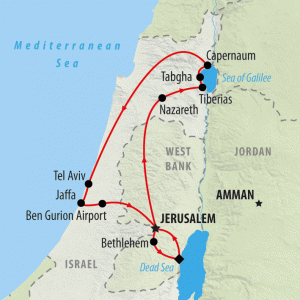
Our first stop – and the bulk of the journey – took us through Israel. We began in Tel Aviv where we took it upon ourselves to walk the Mediterranean coastline and the old city of Jaffa (Yafo). Historically, the hill on which Jaffa resides had a strategic importance since its possible to look out over the vast body of water to the west and the shape of the landscape was used as a natural harbor. Archaeological evidence suggests the area’s been inhabited for almost 10,000 years!
Modern Jaffa is home to 46,000 residents, most of whom are Jewish, as well as churches, synagogues, and mosques. Walking around the brick and cobblestone streets, the first thing you’ll notice is the plethora of high-end galleries and boutiques – art, jewelry, and clothing. It seems as though the residents and local government have been attempting to draw wealthy tourists to the streets.
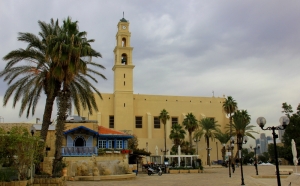
On day 2, our tour officially began and we took a bus southeast, first to Masada and then to the Dead Sea. Masada is an ancient fortification that overlooks the lowest point on earth (1,400 feet below sea level). King Herod the Great built a stronghold and palace atop the mountain, but the real story of Masada doesn’t begin until 150 years later.
Following the Jewish uprising and revolt against the Romans in the year 66 AD, a group of zealots (or sicarii) and their families fled Jerusalem to Masada. The Roman army pursued them and after years of constructing ramps in an effort to lay siege to the fortress, attacked. Instead of submitting to their enemies and becoming slaves, 960 inhabitants burned their stores of food and committed mass suicide. The soldiers discovered the bodies and nothing else.
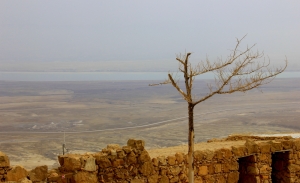
Far below the mountain lies the Sea of Death (or the Sea of Salt). The lowest point on earth has blossomed into a spa resort with companies on both the Israeli and Jordanian shores packaging and selling the various minerals found in the region as skin and hair care products. Thankfully, we brought our bathing suits so we could take a quick dip in the water.
The Dead Sea water contains such high concentrations of salt (over 34%) that marine life cannot survive. It isn’t only the deepest body of water, it’s also the saltiest. The presence of these minerals create such dense water, that humans will float with minimal effort. In fact, it’s actually quite difficult to stand on the sea floor!
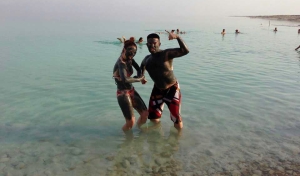
The water acts like anti-gravity, constantly pushing upward. Because the minerals aren’t just in the water (they’re in the soil too), its recommended that visitors take mud baths and wash it off in the sun. The health benefits to your skin are supposedly, invaluable. I wasn’t too impressed, but it certainly was fun getting dirty!
Over the next week, we continued our tour through the land of Canaan. We stopped in Jerusalem, Bethlehem, Nazareth, and the Sea of Galilee (those stories will be in the next article). After following in the footsteps of Jesus, we had a couple days left before our quest would take us out of Israel altogether.
The only aspect of Jerusalem I’d like to mention in this article is the Dome of the Rock. Situated on the site of King Solomon‘s Temple within the Old City (on the Temple Mount – aptly named), only people of the Islamic persuasion are allowed to go inside. However, Jen convinced the guard she was Muslim – thanks to her Turkish residence permit and a cleverly packed head scarf, or hijab. She became the first non–Muslim in over 15 years to enter and take photos of the mosque’s interior (prior to 1999, tourists were allowed to go in). Tradition states that the ‘rock’ on which the dome was built is the actual slab Abraham used to try sacrificing his son. God sent a ram/goat/sheep instead for the ritual, thus sparing Isaac (or Ishmael). For more information, check out my article: Isaac and Ishmael.
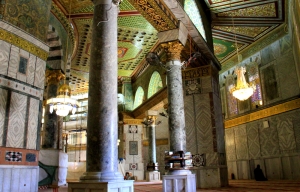
We drove through the Golan Heights – a plateau in northern Israel that previously belonged to both Lebanon and Syria. Great battles were fought between 1948 and 1967 with armies marching through the valley. From the highway, it is possible to see both bordering countries. Other than a few trenches and underground bunkers, there wasn’t much to see and even less interesting about this area of the Middle East (except that the scenery is substantially greener than one might expect).
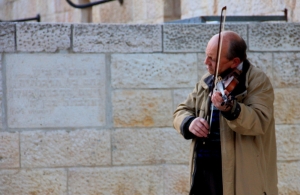
While we were in northern Israel, instead of a hotel, we stayed in a Kibbutz – an interesting experience to say the least. If you’re unfamiliar, a kibbutz is akin to a commune, but it’s the Jewish version. Families residing in the kibbutz raise their children as part of the community – adults live in one building while all the kids live in another. Offspring don’t refer to their biological parents as ‘Mom’ and ‘Dad’ but address all the adults by first name. Life in the kibbutz consists of playtime, studytime, and even worktime.
Unfortunately, the biggest issue with the kibbutz was the remote and rural location. There was nothing around for miles (other than the Lebanese border – which we couldn’t cross in spite of our best efforts). Dinners, not provided as part of the tour costs, were prepared and served by the people of the kibbutz and cost $30 USD per person!
This doesn’t sound like a big deal until you consider the fact that until this point, we’d been spending about $3 USD per person for a meal. Neither Jen nor myself intended to break our budget so I pulled one of the servers aside and offered him a big tip if he’d ‘look the other way’ and allow us into the dining hall to eat. He agreed and for the two night stay, we essentially paid $6 USD per person for dinner – a huge savings!
The final day in Israel took us to Haifa, the nation’s third largest city, Akko and Tiberias. All coastal cities butting up to the Mediterranean, Haifa is famous for becoming the center of the Baha’i religion and home to Mt. Carmel. Baha’i is an offshoot of Islam, created in 19th century Persia (present day Iran) by Mirza Husayn Ali Nuri and combines faith and science. Major tenants of Baha’i include:
- World Peace
- Equality of Men and Women
- Universal Education
- Cooperation between Religion and Science
- Belief in One Universal God
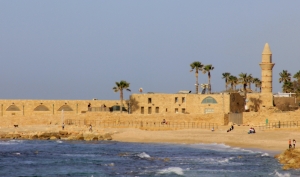
The city of Akko (formerly known as Caesarea) became famous during the Crusades and the Hospitaller Order founded and maintained a strong presence in the city during the Middle Ages and Renaissance. The oldest section juts into the sea like a narrow peninsula, which made it an ideal location for a couple reasons. The first was how easily the city could be defended against invaders, and the second was how quickly an invading fleet could be spotted. The Crusader Fort is still being excavated (much of it lies buried underground), but thankfully, our guide gave us an opportunity to explore on our own through the ‘in-progress’ tunnels. I truly felt like Indiana Jones for the second time in my life (please refer to the article on Angkor if you’d like to read about the first time). Sorry for the lack of photos, there was barely any light down there.
Speaking of our guide… Shooky was quite the character. He not only gave us a tour of the Holy Land, but also provided us with some much needed inside information on the tensions between the Israelis and Palestinians. Apolitical isn’t the adjective to describe our guide and he made his views abundantly clear from day one. Based on his views, it’s no wonder there hasn’t been peace in the region. It’s a shame that people expend so much energy playing the victim when they should be working to find creative solutions to the problems and actually get along for a change. I’m sure Rodney King would have a few things to say to the Israelis.

I highly recommend traveling to this part of the world, particularly if you are or have been religious in the past. The three major monotheistic religions share so much history and culture in the Holy Land, I cannot think of a more appropriate name. If you decide to go, please note that there is one tour company: Consolidated Tour Organization (CTO) that all other private companies feed into. They will be the ones literally conducting the tour so when you go online to look for a company with good reviews, you might as well skip the middle man and hire them directly.
Until Next Time…
-Justin
I’m enjoying your articles and travels-keep ‘em coming !–Gran